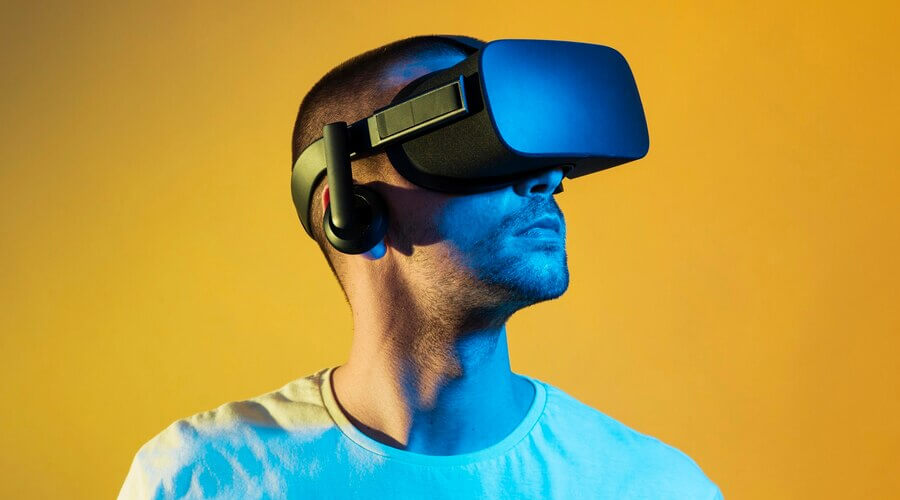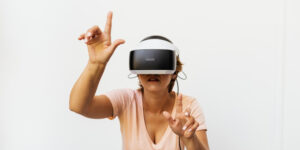
Wearable technology is undergoing a phenomenal transformation with the advent of Augmented Reality AR glasses and AR headsets. These cutting-edge gadgets are poised to revolutionize our interaction with the digital realm, seamlessly blending digital information into our daily lives. Lets find out the main differential features with AR glasses vs AR headsets comparison.
Introduction
AR glasses, known for their compact style, offer convenience and adaptability.
In contrast, AR headsets, with their immersive capabilities, open doors to limitless experiences. This blog delves into the face-off between AR glasses and headsets, exploring their unique attributes, applications, and potential to determine the future’s ultimate wearable tech champion.
Understanding Augmented Reality (AR)
A. Augmented reality (AR) is a technology that overlays digital information, like images, videos, or 3D models, onto reality. The seamless integration of virtual elements into the physical environment enhances our perception. Key features include real-time interaction, a combination of real and virtual worlds, and anchoring digital content to specific physical objects or locations.
B. AR technology is making a substantial impact across various industries. In healthcare, surgeons use AR to visualize patient data during operations, while in education, students can engage with interactive AR textbooks. Industries like gaming, retail, and automotive have embraced AR for immersive experiences, product visualization, and enhancing safety.
C. AR has the potential to revolutionize how we interact with the digital world by simplifying and democratizing technology. It offers hands-free information, navigation, and assistance, transforming everyday activities and fostering new ways of communication, learning, and entertainment. As AR technology advances, it holds the promise of reshaping our digital interactions in profound ways.
Detailed Article: Augmented Reality – The Next Revolution in Digital System
The Rise of Wearable Technology
A. The evolution of wearable technology has been a remarkable journey, beginning with early innovations like fitness trackers and smartwatches. These devices focused on health monitoring and notifications. Over time, they became more sophisticated, incorporating features like GPS, heart rate monitoring, and even cellular connectivity. The natural progression led to the development of Augmented Reality (AR) devices like AR glasses and headsets.
B. There’s an ever-increasing demand for hands-free, on-the-go computing solutions. With our busy lives, people seek seamless access to information and connectivity without being tethered to traditional screens. This demand has driven the evolution of wearables from basic notifications to more immersive and interactive experiences.
C. AR glasses and headsets perfectly align with this trend. They offer the ultimate in hands-free computing, enabling users to access information, interact with digital content, and stay connected to the digital world while being fully immersed in their physical surroundings. This convergence of AR and wearables is destined to redefine how we interact with technology, making it more intuitive and seamless.
AR Glasses: The Future of Convenience

A. AR glasses are designed as lightweight, unobtrusive eyewear that closely resembles conventional glasses. They incorporate a small display near the wearer’s field of view and often feature a microphone, speakers, and sensors discreetly integrated into the frames.
B. AR glasses offer remarkable advantages in terms of portability and style. Their sleek, unassuming design makes them more socially acceptable, blending seamlessly into everyday wear. This contrasts with bulkier AR headsets, which can be conspicuous and less fashionable.
C. The real-world applications of AR glasses are diverse and promising. They excel in navigation by overlaying maps and directions onto the wearer’s view, enhancing safety and convenience. In education, AR glasses enable immersive learning. In professional settings, they enable remote collaboration, with experts guiding a live feed, making AR glasses a convenient and versatile wearable technology.
AR Headsets: The Powerhouse of Immersion

A. AR headsets are bulkier than AR glasses, resembling a visor or helmet. The user’s vision and hearing are immersed completely. AR headsets incorporate advanced optics sensors and often feature a wide field of view, enabling a high degree of immersion.
B. AR headsets offer unparalleled immersive experiences. They can create virtual environments where digital content seamlessly interacts with the physical world, giving users a sense of being inside the digital space. This immersion extends to audio, enhancing the feeling of presence and engagement.
C. AR headsets find applications in various domains. Gamers can enjoy profoundly immersive gameplay, architects and designers can visualize 3D models in real time, and in the medical field, surgeons can access patient data and 3D images during surgeries. Their potential for immersion makes AR headsets a powerful tool in industries that require highly interactive and visually rich experiences.
Technical Considerations
A. When comparing AR glasses and AR headsets, there’s a significant difference in hardware. AR glasses are typically lighter and more compact, while AR headsets are more significant and house more robust components. AR headsets often feature more advanced optics and sensors to deliver immersive experiences.
B. In terms of processing power, AR headsets tend to have more powerful processors to handle complex 3D rendering and computations. However, this often results in shorter battery life compared to AR glasses. Connectivity options vary but commonly include Wi-Fi and Bluetooth for both device types.
C. Comfort and ergonomics are crucial for wearable AR devices. AR glasses are often favored for extended wear due to their lightweight design. AR headsets must carefully balance comfort with their more prominent form factor to ensure users can wear them for extended periods without discomfort or fatigue.
Challenges and Limitations
A. AR glasses encounter challenges like a limited field of view, restricting the amount of digital content that can be displayed simultaneously. This constraint hinders the depth of immersion and the ability to interact with a broad digital environment.
B. On the other hand, AR headsets face drawbacks in terms of bulkiness, making them less comfortable for extended use. They also grapple with social acceptance issues, as their appearance can be imposing or awkward in everyday scenarios.
C. The AR industry is actively working on addressing these challenges. For AR glasses, ongoing developments aim to expand the field of view, enhancing the user’s immersion. AR headsets are becoming more lightweight and ergonomically designed, and efforts are being made to make them more aesthetically appealing, ultimately improving social acceptance. The future promises solutions that will make both AR glasses and AR headsets more accessible and functional.
Market Landscape
A. The current market of AR glasses vs AR headsets is marked by rapid growth and innovation. Several companies have introduced consumer-focused AR glasses catering to entertainment and productivity. Meanwhile, AR headsets find extensive use in enterprise industries, such as healthcare and manufacturing. Market value is steadily climbing, reflecting increasing consumer interest and industry adoption.
B. Key players in the AR landscape include industry giants like Apple, Microsoft, and Google, each offering distinctive AR products. Their contributions span hardware advancements, software ecosystems, and innovative applications, driving the industry’s evolution.
C. The future of AR glasses and headsets is bright, with projected market growth driven by improved hardware, more versatile software, and a broader range of applications. Innovations in healthcare, gaming, education, and remote work will likely fuel market expansion, making AR devices a transformative part of our digital future.
User Adoption and Social Impact
A. The acceptance and adoption of AR glasses and headsets vary. While tech enthusiasts readily embrace the potential, mainstream adoption is gradual due to price constraints and concerns about the learning curve. As the technology grows and becomes more user-friendly, wider acceptance is anticipated.
B. Socially, these devices raise privacy concerns, as they can record images and videos discreetly. Additionally, the potential for distraction in public spaces poses challenges. Balancing convenience with privacy will be crucial.
C. AR glasses and headsets have the potential to reshape daily life by offering hands-free access to information, seamless communication, and enhanced productivity. They can revolutionize remote work, education, healthcare, and entertainment, making them integral to how we live, work, and interact in the digital age.
Conclusion
In the quest to determine the future of wearable technology, the competition between AR glasses and AR headsets is dynamic and exciting. Both devices offer remarkable advantages, with AR glasses focusing on convenience and style while AR headsets deliver unparalleled immersion. As technology continues to evolve, each has its unique role to play in reshaping how we interact with the digital world.
Ultimately, the choice between AR glasses and AR headsets may come down to personal preferences and specific use cases. What is undeniable is that the fusion of augmented reality with wearables is set to redefine our daily lives, offering us a glimpse into a more connected and immersive future.






